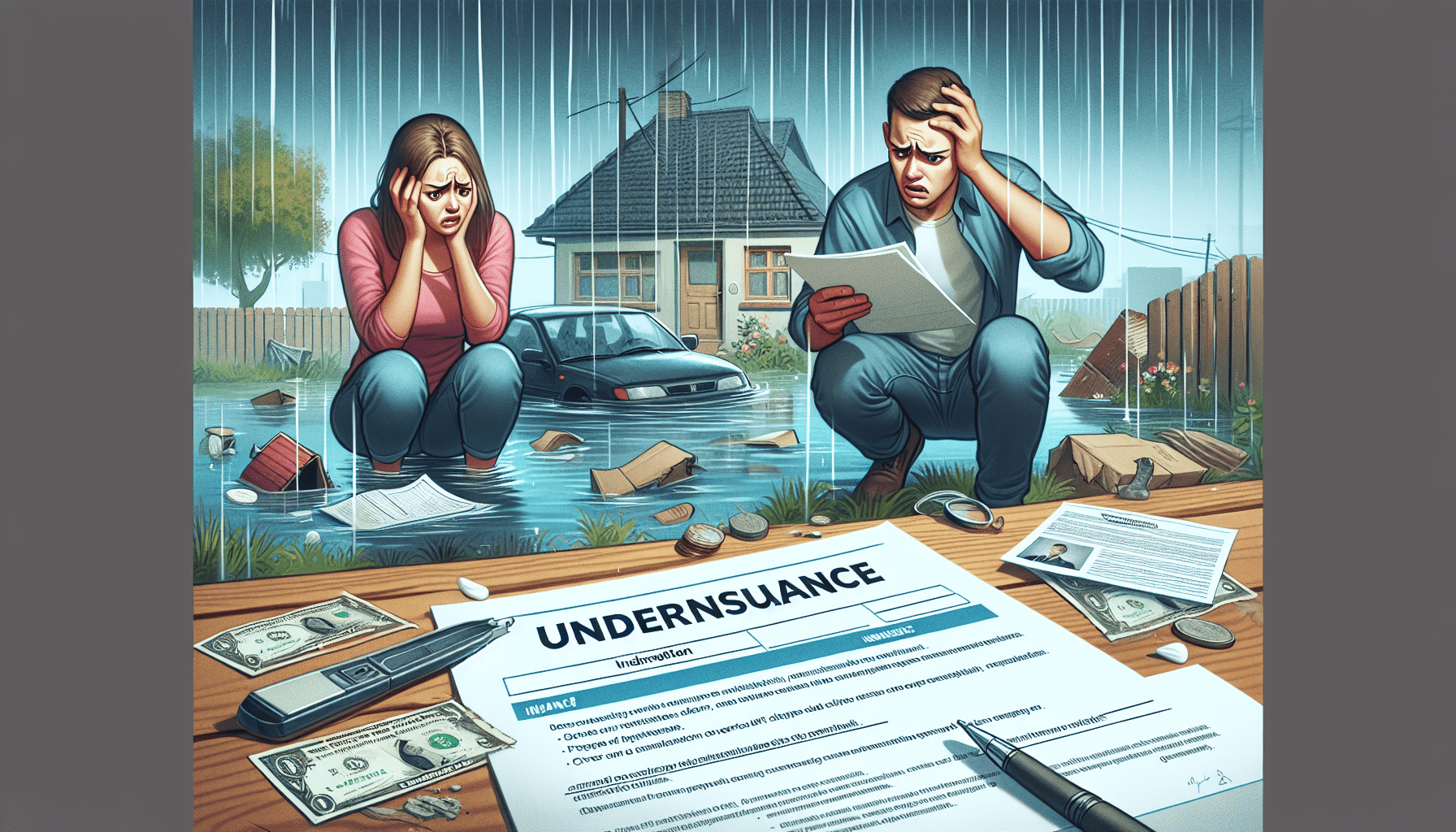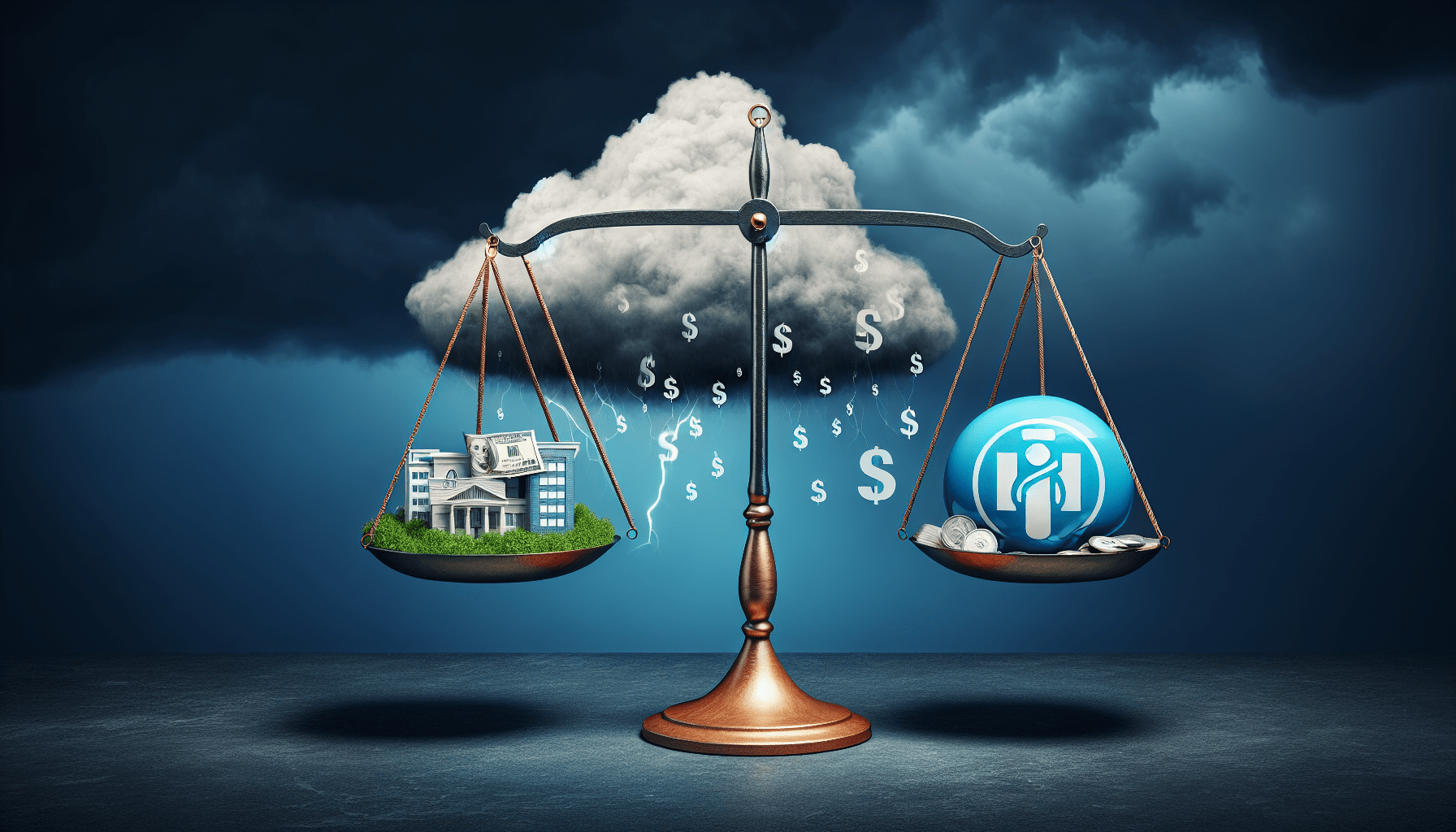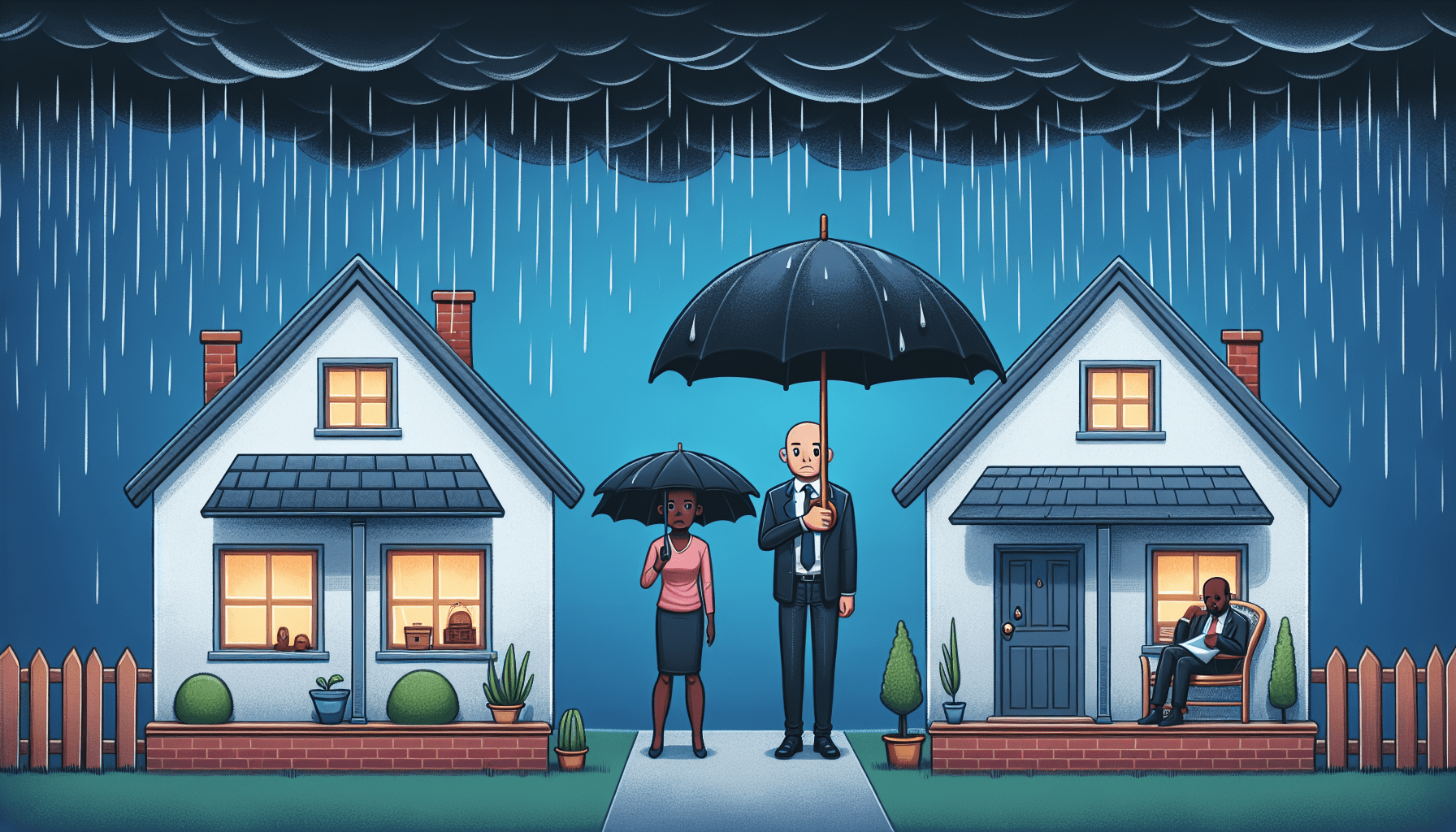Underinsurance: The Silent Threat Lurking in Your Policy
Did you know that an average of 20% underinsures 40% of U.S. homeowners?
Being underinsured means your insurance policy may fall short of covering the full cost of repairing or rebuilding your home in the event of a disaster, such as a fire, flood, or other catastrophic occurrences. This coverage gap can result in substantial out-of-pocket expenses, leaving homeowners unprepared to manage the financial burden.
Moreover, the emotional toll of losing personal belongings and the security of your home is compounded by the financial stress of not having sufficient funds to recover, pushing some families to the brink of bankruptcy. Imagine this: A wildfire destroys your home, but your insurance payout covers only half the rebuild cost.
You drain savings, take loans, and still face homelessness. This is underinsurance—a gap between your coverage and actual risks—and it’s a financial time bomb. Underinsurance doesn’t just leave you vulnerable; it quietly amplifies liabilities, erodes wealth, and can trigger bankruptcy. Let’s expose the 10 hidden costs no one warns you about.
1. The Rebuild Gap: Why Your Home’s Market Value ≠ Insured Value

Subheading: Many homeowners believe their insurance coverage should align with their home’s market value, but this assumption can be misleading. Market value depends on factors like location, land worth, and real estate trends, while the rebuild cost is driven by construction expenses, materials, and labor—key considerations that ensure adequate protection.
If a disaster occurs, your insurance payout may not cover the full cost of restoring your home to its previous condition. This disparity can lead to out-of-pocket expenses that many are unprepared for, turning what should be a safety net into an unexpected financial burden.
“Is your home’s rebuild cost higher than its market value?”
Most homeowners confuse market value with rebuild costs. Construction materials, labor, and post-disaster demand can spike expenses by 30-50%.
Case Study: In the aftermath of a disaster, homeowners like the Johnsons found themselves in a precarious position. Their insurance coverage was determined by their home’s market value rather than the cost to rebuild, resulting in a significant shortfall when reconstruction was needed.
This is a common oversight that can lead to a financial strain, as the cost to rebuild often exceeds the initial estimates, especially when accounting for the surge in prices for materials and labor following a widespread event.
After California’s 2018 Camp Fire, underinsured homeowners faced $150K+ out-of-pocket rebuild costs (source: Insurance Information Institute).
Actionable Fix:
1: Homeowners should routinely evaluate and update their insurance policies to tackle this pressing concern effectively. Regular updates help ensure coverage limits align with the ever-changing costs of materials and labor, preventing potential gaps in protection.
Professionals suggest performing this assessment annually or following any major shifts in the market or personal situation, such as renovations or upgrades that might elevate the property’s value.
Homeowners can reduce the risk of being underinsured during a disaster by staying proactive and well-informed. Consider utilizing tools such as Guaranteed Replacement Cost riders to ensure comprehensive coverage.
2: Strengthen your home’s protection by incorporating AI-driven personalization into your insurance plan. Cutting-edge algorithms can process extensive data to customize coverage, addressing unique risk factors tied to your property and lifestyle.
This means that your insurance is no longer a one-size-fits-all solution, but rather a dynamic policy that adapts to changes in your life and shifts in the environment, ensuring that you always have the optimal level of coverage. Consult rebuild calculators from AccuCoverage or MSB.
2. Medical Bankruptcy: Underinsurance in Healthcare

Subheading: One of the most harrowing consequences of inadequate health insurance is the risk of medical bankruptcy. This financial catastrophe strikes countless families each year, as unexpected illnesses or accidents result in towering medical bills that far exceed the limits of their insurance policies.
To reduce this risk, it’s essential to carefully evaluate your healthcare needs and select a policy that provides robust coverage, including out-of-pocket maximums to shield your savings during medical emergencies. This proactive approach helps protect both your health and financial stability from life’s unexpected challenges.
“How does underinsurance turn a hospital visit into lifelong debt?”
44% of Americans avoid medical care due to costs, yet 23% are underinsured (CDC). High deductibles and excluded treatments (e.g., cancer therapies) can bankrupt families.
Example: Medical debt isn’t just a metaphorical burden; it’s a harsh reality affecting countless lives. For underinsured patients, emergencies or specialized treatments frequently lead to an overwhelming financial crisis, leaving them entangled in a maze of bills far beyond their capacity to pay.
The aftermath is not only a battle with illness but also an enduring fight against the relentless tide of collection calls, reduced credit scores, and the ever-present threat of bankruptcy that can decimate their economic stability for years to come. A $200,000 cancer bill along with a $40200K cancer bill, resulting in a total debt of $4,080,000.
Solution:
1: To address this daunting challenge, AI personalization emerges as a beacon of hope, offering a sophisticated approach to managing and mitigating the financial burdens of healthcare.
By harnessing the power of machine learning and data analytics, AI systems can tailor payment plans and financial assistance programs to individual circumstances, ensuring that patients are not overwhelmed by one-size-fits-all demands.
This tailored approach safeguards patients’ credit standing, enabling them to focus on their recovery without the stress of excessive financial strain. Explore the benefits of Critical Illness Insurance.
2: Harnessing the power of AI personalization in healthcare finance goes beyond merely tailoring payment plans. It involves a sophisticated analysis of individual patient data, including past payment histories, current financial status, and even predictive behaviors to anticipate future financial capabilities.
This technology helps healthcare providers create flexible pricing and payment options that adjust to a patient’s financial situation, making medical bills more affordable and encouraging active participation in their care.
This approach strengthens the patient-provider bond and reduces defaults, supporting a more reliable healthcare system. Check yearly policy updates for coverage changes.
3. Business Interruption: The Domino Effect of Underinsurance

Subheading: Inadequate insurance coverage leaves businesses vulnerable, where one disruptive event can trigger a cascade of challenges. Whether faced with a natural disaster, a cyber-attack, or another crisis, underinsured companies risk lacking the financial resources needed to bounce back effectively.
This domino effect can lead to extended downtime, loss of customer trust, and in severe cases, complete business failure. It’s essential for businesses to regularly assess their coverage to ensure it aligns with their current risk profile and the ever-evolving business landscape.
“Could your business survive a 6-month shutdown?”
Small businesses often skip “business interruption” coverage. Post-disaster, 43% never reopen (FEMA).
Case Study: Business interruption coverage is a critical financial lifeline when unexpected events disrupt operations. Consider the case of a local bakery that was forced to cease operations for several weeks due to a mandatory evacuation caused by a gas leak.
Fortunately, their comprehensive insurance plan included business interruption coverage, which provided the necessary funds to cover ongoing expenses and lost income during the closure, ultimately enabling the bakery to reopen its doors without bearing the full brunt of the disaster’s financial impact. A bakery’s flood insurance covered repairs but not lost income, leading to closure.
Tip: AI personalization helps businesses, like this bakery, tailor customer experiences to individual preferences, increasing engagement and loyalty.
The bakery uses AI to predict customer buying habits, create personalized marketing, and update inventory instantly based on demand trends.
This level of personalization not only helps in recovering lost income but also positions the bakery to capitalize on emerging market opportunities, turning a period of adversity into a stepping stone for innovation and growth. Add Contingent Business Interruption insurance to protect against supplier or utility failures.
4. Liability Lawsuits: The $1M Lawsuit You Never Saw Coming

Subheading: In today’s unpredictable business environment, liability lawsuits can pose significant threats to unprepared entrepreneurs. Whether stemming from an alleged contract breach, a customer injury on your property, or a product defect claim.
It is essential for businesses to proactively safeguard themselves with comprehensive liability insurance, which can provide a critical financial shield, ensuring that a single legal battle doesn’t spell the end for your hard-earned venture. “Are your liability limits a legal bullseye?”
Auto or home liability limits as low as 100K won’t cover 100K won’t cover a 1M lawsuit.
Real-Life: In the face of such daunting figures, it’s imperative for business owners and individuals alike to reassess their liability coverage and consider the benefits of umbrella insurance policies.
Supplemental plans offer extra coverage after your main policy is used up, adding financial protection. They help cover claims of hundreds of thousands or even millions of dollars.
Without proper protection, you risk your assets, future income, and financial security—an unnecessary gamble. For instance, one homeowner faced a $750,000 dog bite lawsuit, surpassing their policy limit.
Fix: To avoid such catastrophic financial fallout, it’s crucial to regularly review and adjust your insurance policies to match your current circumstances. This includes not just the value of your assets, but also potential changes in your lifestyle that could increase your liability risks.
Consulting with an insurance specialist can help you identify any gaps in coverage and ensure that you have the right protections in place to shield you from unexpected legal judgments that could otherwise devastate your financial future. Umbrella policies add 1M+coverage for 1M+coverage for 20/month.
5. Depreciated Value Traps in Auto Insurance

Subheading: When considering auto insurance, it’s crucial to understand the concept of depreciation and how it affects the value of your vehicle over time. Many insurance policies will only cover the actual cash value of your car at the time of an accident, not the price you originally paid.
As your car loses value, insurance payouts may not fully cover replacing it. This could lead to unexpected expenses that strain your budget. Review your policy and explore options like new car replacement coverage.
“Is ‘Actual Cash Value’ costing you thousands?”
Insurers often pay “actual cash value” (depreciated), not replacement cost. A totaled 5-year-old car might net 8K vs. 8K vs. a 15K replacement.
Solution: To ensure you’re not left out of pocket, it’s essential to understand the terms of your auto insurance policy. Opting for replacement cost coverage can provide peace of mind, as it promises to cover the cost of purchasing a new vehicle of the same make and model, minus your deductible, in case of a total loss.
This way, you’re not just getting the depreciated market value of your car but the actual amount you’d need to get back on the road without dipping into your savings. Add GAP Insurance for leased/financed vehicles.
6. Hidden Climate Risks in Property Insurance
Subheading: When considering property insurance, it’s crucial to the hidden climate risks that may not be immediately apparent. As extreme weather events become more frequent and severe due to climate change, the potential for property damage increases significantly.
Insurers are adapting by updating their risk models, but as a policyholder, you should proactively assess your coverage to ensure it reflects these evolving risks. This might mean seeking additional coverage for natural disasters or reviewing your policy’s limits and exclusions to avoid unwelcome surprises after a climate-related event.
“Does your policy exclude floods or earthquakes?”
Standard policies exclude climate-specific risks. 70% of flood losses occur in non-flood zones (NFIP).
Action Step: Know your policy thoroughly, especially as the weather becomes less predictable. Standard policies don’t cover all risks, so consider adding supplemental coverage.
For instance, acquiring flood insurance through the National Flood Insurance Program (NFIP) or a private insurer could provide the necessary financial safety net if your property is situated in an area increasingly prone to flooding, regardless of historical flood zone designations. Use FEMA’s Flood Map Service Center to assess risk.
7. Underinsured Mental Health Coverage

Subheading: As climate patterns shift and mental health awareness grows, the gap in mental health coverage becomes more apparent. Many insurance policies fall short when it comes to providing adequate mental health services, leaving policyholders vulnerable in times of need.
It is crucial to review your health insurance plan to ensure it includes comprehensive mental health coverage, especially as the demand for these services increases in our fast-paced, high-stress society.
By proactively addressing this often-overlooked aspect of health care, individuals can safeguard their well-being and avoid the financial strain that can accompany underinsured mental health care.
“Are therapy sessions breaking your budget?”
Despite parity laws, 56% of mental health providers are out-of-network (APA), leaving patients with $150+/session bills.
AI personalization offers a groundbreaking solution to financial barriers in mental health care. Using advanced algorithms and machine learning, AI platforms can customize therapy to fit individual needs, often at a much lower cost than traditional methods.
This not only makes mental health care more accessible but also ensures a personalized approach, increasing the likelihood of positive outcomes for users seeking support. Verify in-network providers annually.
8. The Inflation Trap: Static Policies in a Rising Economy
Subheading: In the face of an ever-changing economic landscape, static policies can often lead to what is known as the inflation trap. This occurs when businesses and individuals are caught off-guard by rising prices and stagnant strategies that fail to adapt.
To avoid falling into this trap, organizations and policymakers implement dynamic approaches that can adjust to inflationary trends, ensuring that economic activities remain robust and responsive to market fluctuations.
By doing so, they can safeguard against the erosion of purchasing power and maintain the stability of the economic environment. “When did you last adjust your coverage for inflation?”
Construction costs rose 17% in 2023 (Forbes). A policy unchanged since 2020 leaves massive gaps.
Tip: To mitigate the risk of underinsurance, it’s essential for policyholders to regularly review and adjust their coverage in line with current market conditions.
This proactive strategy protects their assets and avoids financial stress from unexpected events.
Insurance providers often offer tools and resources to help customers understand the impact of inflation and make informed decisions about their coverage needs. Enable Inflation Guard endorsements.
9. Supply Chain Gaps in Business Insurance
Subheading: Supply chain disruptions greatly affect businesses by impacting inventory and delivery schedules. To manage these risks, insurers now offer coverage tailored to supply chain challenges.
These policies offer financial protection against losses from supply chain delays, interruptions, or failures, helping businesses recover quickly and keep operations running smoothly during unexpected challenges.
“What if your supplier goes bankrupt?”
Global disruptions mean delays can sink businesses. Most policies exclude supply chain failures.
Solution: To mitigate these risks, AI personalization steps into the fray, offering a tailored approach to supply chain management. By analyzing vast amounts of data and recognizing patterns that might indicate a supplier’s financial distress, AI-driven systems can alert companies to potential issues before they become critical.
This proactive stance allows businesses to diversify their supplier base or implement contingency plans, thereby minimizing the impact of any single supplier’s failure on the overall supply chain. Supply Chain Insurance for critical vendors.
10. The Coinsurance Penalty: A Hidden Fine for Underinsuring

Subheading: The coinsurance penalty is an often overlooked aspect of insurance policies that can have significant financial consequences for businesses.
It is a clause requiring the insured to cover part of the loss if the property or assets are not insured for a specific percentage of their value, usually 80-90%.
If a company undervalues its insured property, the insurance payout might be much lower, forcing the business to cover the difference itself.
“Did you know underinsuring your home can lead to penalties?”
Insuring just 80% of your home’s value means insurers may reduce your payout. For example, a $200K claim could be reduced to $150K.
Formula: The underinsurance penalty, called the “co-insurance clause,” is often hidden in insurance policy details. Policyholders understand this clause, as it impacts the reimbursement after a loss.
To avoid such penalties, it’s essential to regularly reassess the value of your insured assets and adjust your coverage accordingly, ensuring that it reflects current market values and replacement costs. (Amount Insured / Required Coverage) x Loss = Payout
5 Practical Tips to Avoid Underinsurance
1: Audit Annually: 2: Update After Major Life Events: Significant changes in your life can greatly affect the value of your assets and your coverage needs. Whether it’s a marriage, divorce, the birth of a child, a home renovation, or acquiring valuable personal property, it’s crucial to inform your insurance provider and reassess your policy.
This ensures that your insurance protection remains in sync with your current circumstances and that you’re not left underinsured at a critical moment. Review policies post-major life events.
2: Understanding the nuances of AI personalization within the insurance industry is paramount to optimizing your coverage. As artificial intelligence becomes increasingly integrated into policy customization, it can analyze vast amounts of data to tailor policies that align closely with individual risk profiles and preferences.
By embracing this technology, policyholders can benefit from more accurate premiums and coverage that adapts to their unique lifestyle changes and asset acquisitions, ensuring comprehensive protection at all times. Use Replacement Cost Calculators (e.g., Dwelling Cost Calculator).
3: Moreover, AI-driven personalization extends beyond tailoring premiums to individual risk profiles. It also enhances the customer experience by streamlining interactions and claims processing.
With AI, insurance companies can offer real-time support and swift claims settlement, reducing the traditional friction points that often lead to customer dissatisfaction.
This strategy enhances efficiency while fostering trust and loyalty among policyholders, demonstrating a genuine commitment to addressing their needs.
4: Using AI to customize insurance options enables the creation of tailored policy bundles that meet unique customer needs. By reviewing a customer’s history, preferences, and risk factors, insurers can recommend ideal policy combinations and offer discounts for bundling multiple policies.
This helps provide complete coverage, filling gaps in a customer’s protection plan. It also highlights the insurer’s value, promoting long-term loyalty and satisfaction. Work with Independent Agents (they compare options from various carriers).
5: Read Exclusions: Understanding policy exclusions is crucial to avoid unpleasant surprises when filing a claim. Policyholders should carefully review the list of exclusions to ensure they are fully aware of what is not covered under their insurance plan.
This knowledge enables them to make informed decisions about additional coverage or alternative insurance solutions that might better suit their unique needs and risk exposures. Scrutinize “fine print” like mold or cyberattacks.
Table Suggestion: Understanding the intricacies of insurance policies can often be overwhelming for the average consumer. AI personalization steps in to bridge this knowledge gap, offering tailored advice and insights into the often obscure language of insurance documents.
Using machine learning, AI systems can review individual risk profiles and preferences, helping users understand their policies, spot gaps in coverage, or identify areas where they might be over-insured.
This customization makes decision-making easier and improves the customer experience by giving them more control and confidence in their insurance options. “Common Insurance Gaps by Industry”

FAQs
Q1: How do I know if I’m underinsured?
A: To determine if you’re underinsured, start by reviewing your current policies and comparing the coverage limits to the potential risks you face. Consider the value of your assets, the nature of your industry, and any recent changes to your business operations.
Consulting with an insurance professional can also provide insights into industry-specific risks and help ensure coverage meets your unique needs. Compare coverage to current rebuild costs, income needs, and liability risks.
Q2: Is underinsurance illegal?
A: Underinsurance is usually not illegal, but it can lead to major financial problems. Without enough coverage, a business faces risks that could cause serious financial trouble or even bankruptcy after a major loss.
Furthermore, certain contracts or industries may require specific levels of insurance, and failing to maintain these can lead to breaches of contract or regulatory non-compliance, which may carry legal penalties.
It’s crucial for businesses to regularly review and adjust their insurance policies to align with their evolving risk profiles and asset values. No, but it’s financially reckless.
Q3: Can underinsurance affect my credit score?
A: Absolutely, underinsurance can have a ripple effect on your financial health, including your credit score. If a disaster strikes and your insurance coverage falls short, you may have to resort to loans or credit to cover the shortfall.
Rising debt can result in higher credit usage, missed payments, or defaults, all of which harm your credit score. Having proper insurance isn’t just about protecting assets—it’s a smart way to protect your financial health and credit. Unpaid claims often end up in collections.
Q4: What’s the cheapest way to fix underinsurance?
A: The most cost-effective strategy to address underinsurance is to regularly review and adjust your coverage to align with current needs and asset values. This proactive approach ensures you’re not overpaying for unnecessary coverage while protecting you from being underinsured.
It’s advisable to consult with an insurance professional who can help assess your situation and recommend tailored solutions that provide adequate protection without breaking the bank.
Regularly check and adjust your coverage to avoid overspending while staying protected. Umbrella policies offer broad coverage at a budget-friendly price.
Q5: Do renters need to worry about underinsurance?
A: Absolutely, renters should be mindful of underinsurance just as homeowners do. While the landlord’s insurance typically covers the building itself, the personal possessions inside and the tenant’s liability are the renter’s responsibility.
Renters often overlook the value of their belongings or the risks of liability, which can result in serious financial problems if theft, damage, or legal issues occur.
Renters must assess their needs and consider a renter’s insurance policy that provides adequate coverage to protect against these risks. Yes—40% lack sufficient liability/personal property coverage.
Conclusion: Close the Gaps Before Disaster Strikes
Grasping the details of renter’s insurance can feel overwhelming, but it’s essential for protecting your belongings and finances. It’s not just about having coverage, ensuring it fits your needs and lifestyle.
Proactive renters should regularly review and adjust their policies to ensure they remain fully protected as their circumstances change, whether they acquire new valuables or move to a different rental property.
Underinsurance isn’t just a minor oversight—it’s a wealth-eroding avalanche. From medical debt to business collapse, the hidden costs compound ruthlessly. Audit your policies, consult experts, and prioritize replacement costs over shortcuts.
Underinsurance is like a hidden leak in your ship—it seems fine until trouble strikes and financial losses sink you. Protect yourself by ensuring you have adequate coverage, not just any coverage.
Take the helm of your financial security today—review your insurance portfolio, ensure adequate coverage, and consider the peace of mind that comes with being prepared for life’s unpredictable storms. Bookmark this article, share it with loved ones and schedule a policy review this week.
Discussion Question: As you contemplate the intricacies of your insurance needs, it’s crucial to recognize the role of AI personalization in shaping your coverage. Cutting-edge algorithms and machine learning techniques are now being employed to analyze your lifestyle, habits, and individual risk factors, tailoring policies to fit you like a glove.
By harnessing the power of AI, insurers can offer more accurate premiums and personalized recommendations, ensuring that your insurance portfolio is as unique as your fingerprint and just as secure. Have you or someone you know faced underinsurance costs? Share your story below.

